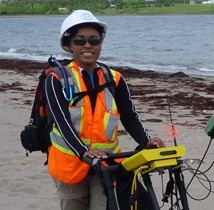Tanya Forde

M. Sc. Thesis
(PDF - 76.1 Mb)
Although many modern coastlines are retreating as a result of global sea-level rise, periods of stability and progradation may result from time-varying sediment supply. In formerly glaciated regions, where sediment is derived primarily from finite glaciogenic sources, sediment input may support progradation for a time, but decline when the source deposit becomes exhausted. For Conrads Beach on the Atlantic coast of Nova Scotia, georectified maps based on aerial photographs, satellite photographs, maps and LiDAR data, coupled with beach profiles and historic records, show that the shoreline has retreated overall during the past ~230 years. The western and eastern shorelines have also experienced stasis and progradation, respectively, over intervals of years to decades, as well as rapid erosion and accretion over periods of days to months, largely as a result of powerful storms. In the 1960s, a tidal inlet formed and filled within a few decades, migrating ~60 m laterally during this time.
To investigate timescales of centuries to millennia, ground-penetrating radar profiles which imaged to depths of 6-8 m were linked to 13 vibracores that penetrated up to 4.2 m, and supplemented by refraction seismic data to 23.5 m depth. Grain-size parameters were used to support facies identification for sand samples. An age profile based on radiocarbon dating suggests that the area was open-marine or littoral at about 2800 calendar years BP. Locally increased sediment supply caused rapid buildup and progradation of beach ridges along the eastern beach from ~600-150 years BP. Landward of the beach-ridge area, cores from a lagoon and marsh connected to the ocean by tidal inlets yield dates that correspond to the period of beach-ridge formation. As the coast retreated, erosion of drumlins provided large sediment pulses over a period of centuries, temporarily building out the coast and creating a lagoon. The results support previous models for the Atlantic coast of short-term progradation in response to intermittent sediment supply from discrete sources, superimposed on prevailing coastal retreat. Conrads Beach may serve as a model for the behaviour of other high-sensitivity coasts with local sediment sources.
To test the Conrads Beach model, comparably detailed studies at other sites would be required. To check whether such studies are feasible, reconnaissance ground-penetrating radar/global positioning system data were collected at five additional Atlantic Canada study sites. These sites represent three distinctive environments of coastal evolution (Atlantic Ocean, Northumberland Strait and Gulf of St. Lawrence) located in areas of both moderate and high coastal sensitivity. Radargram facies similar to Conrads Beach were identified, study site features were compared and sediment sources evaluated. Aerial photographs, satellite photographs, maps and LiDAR were also located for some of these sites. The abundance of aerial/map data and encouraging preliminary ground-penetrating radar results suggest that the Conrads Beach model could be tested at those locations.
Keywords: Conrads Beach, Coastal barrier system, Ground-penetrating radar, Nova Scotia, transgressive coast, sea-level changes, coastal geomorphology, global positioning system, seismic refraction, vibracore, radiocarbon dating, grain-size analysis
Pages: 207
Supervisors: Martin Gibling, Mladen Nedimovic



